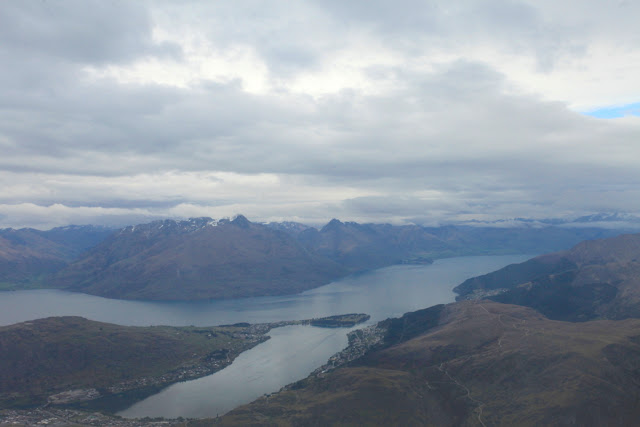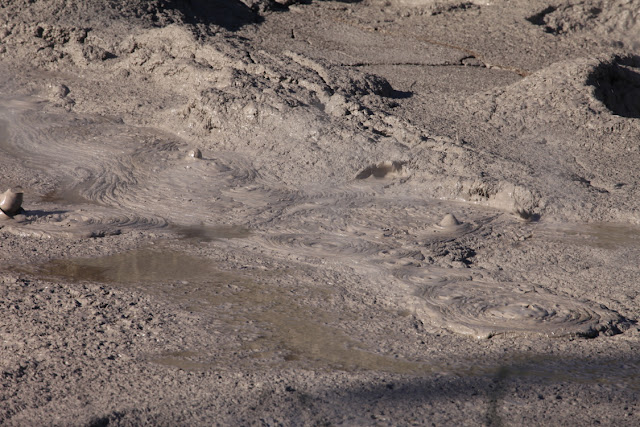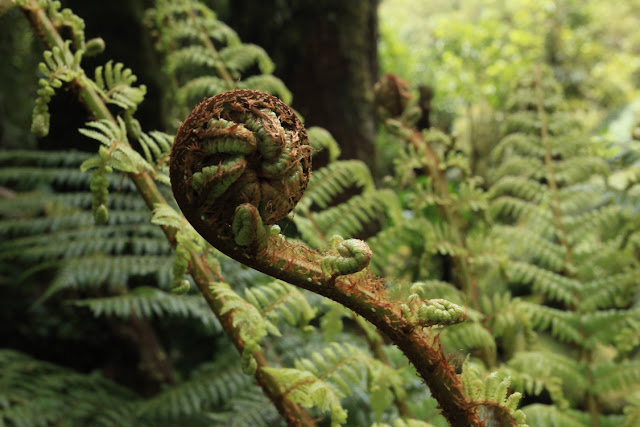There were just two more stops on this Smithsonian Journeys trip to Australia and New Zealand and both were on the North Island.. I had not previously been to the North Island so I was curious to see just how different it was from the South.
Leaving Queenstown we got a great view of Lake Wakatipu. At 50 miles long, it is New Zealand's longest lake and one of the deepest at 1,250 feet. The mountains around the lake (center) are known as The Remarkables.
These are the Canterbury Plains south of Christchurch, one of the largest growing regions in the country.
The mountains seemed endless on this flight! One usually thinks of New Zealand as a small place but the topography actually makes it a very big place. This is the Kaikoura Range with a maximum elevation of 9,465 feet on Mt. Tapuaenuku.
This is the Marlborough Sound in the extreme northeast corner of the South Island. Note the clear-cut logging occurring on the lower slopes of the peninsula.
This is the Cook Strait located between the North and South islands
While flying over the Cook Strait, I could look ahead to the west and see the Egmont volcano, now known by its local Maori name of Mt. Taranaki. Note the parasitic cone on its left (south) flank known as Fanthanms Peak, This beautiful strato-volcano is one of the most symmetrical in all the world and began forming some 135,000 years ago with its last eruption in the 1850's. See a good article on the volcano here and look at the unusual national park boundary around the cone here.
I was sitting on the correct side of the airplane because next in view was the Ruapehu volcano. Note the blue crater lake on its crest. A lot of geologic information about this cone can be found here on the Volcano Discovery web site.
Just north of Ruapehu is Ngauruhoe volcano
And just north again is the Blue Lake (bottom). What a spectacular geologic flight this was! I will have to come back and check these out on the ground one day.
After landing in Rotorua, we walked through a memorial grove of California redwood trees that were planted in 1901 to replace the native forest that was being cut for agriculture. The trees have grown quite large in this humid environment in their 114 years - see the person at the base of the left hand tree.
Although not as tall was the redwoods, the tree ferns were also spectacular
The Maori have opened a cultural park around the Te Puia geothermal area, just four miles from the city center of Rotorua.
Many aspects of Maori culture are on display here including wood carving, fabric making, geothermal cooking, and crafts.
This is the Pohutu geyser which is in constant eruption! It never stops.
Boiling mud pots on the way to the geyser can be seen and are always a fan favorite in geothermal areas.
Closer view of Pohutu geyser
Close-up view
That evening, we enjoyed a meal that was cooked in the ground in the traditional Maori way. Here the chefs are removing the food from the underground oven.
This is the former bath house in Rotorua, now the main museum in town. It has excellent exhibits which are a must-see when in Rotorua. Well done!
View of the sulphur bay on Lake Rotorua from the roof of the museum
Lake Rotorua sits within the caldera of the same name. This 14-mile diameter depression was formed about 240,000 years ago when a volcano lots its top and the region sank on top of an empty magma chamber. The activity is not over but there has not been an eruption here since about 25,000 years ago. All of these feature are part of the Taupo Volcanic Zone.
Black swan on Lake Rotorua
Rotorua has numerous examples of toon trees, which have been introduced from China. We were here just in time to see the leaves before they turn green.
I liked this view seen upon entering the Maori village of Ohinemutu in Rotorua. A Maori icon set against the European steeple of a church.
This is the front side of the Maori icon. Note the tongue distended with wide eyes, a typical Maori show of strength.
Adventure and foreign travel, philosophical and scientific musings, geology and landscapes, photography and earthly explorations.
Sunday, November 29, 2015
Sunday, November 15, 2015
A Day in Milford Sound, New Zealand
As long as I can remember, I have known about the Milford Track near Milford Sound. In the 1970's, it seems like lot's of Americans who loved trails and long hikes would talk about a fantastically beautiful trail located on New Zealand's South Island. Although there was no time for me to hike the track on this trip, it would be my distinct pleasure to visit Milford Sound.
Large gum trees on the shores of Lake Te Anau, in the city of the same name
On the road into Milford Sound, the scenery is fantastic. Each of these long valleys were filled with glacial ice just 10,000 years ago.
One of the many stops along the way is Mirror Lakes, a series of oxbow lakes (where the main river used to flow but now filled with lake water).
Creative signage at the lakes
Having fun with photographs
We were lucky to have such a high ceiling to see the peaks
The infrastructure in the New Zealand parks is really nice
Large side stream within Fiordland National Park. This area of New Zealand has over 3 million acres of protected landscapes, from the southern tip of the island up to Mt. Cook National Park. It is an exceptional area of protected land. The drainages are steep, even this close to sea level.
After driving in the park for 80 miles, the road encounters a 2,000 foot sheer wall of granite. There was no way a road could be constructed on this wall and so the 1.2 kilometer Hamner Tunnel was blasted into the wall in the 1930's and '40's to get across the divide. This is a view down to the sea side of the road.
Looking back to the north side tunnel
This kea bird came down to the vehicles while we were photographing the area
The bird came down to eat the rubber off of the vehicles parked here
They are beautiful birds but very cagey and sheer terror for any rubber on the vehicles
The temperate rainforest is beautiful beyond description. New Zealand has been separated from Gondwana fore the last 80 to 60 million years and so the vegetation has a certain Mesozoic quality to it.
This is a place called The Chasm, where a side stream has etched a narrow slot some 50 feet deep through limestone.
More tree ferns
New Zealand is known for its jade rock, which comes from the west coast of the South Island
This is Mitre Peak, one of the most photographed scenes in the whole country. This is deep glaciated country.
More glacial scenery in Milford Sound, where we took a four hour boat cruise
A hanging valley in the fjord
Milford Sound is not that long of a fjord, being only about five miles in. Here is the open ocean and the Tasman Sea. Only 1,300 miles out there to the coast of Australia.
Note the glacial striations sweeping down from the left across this rock face
Spectacular waterfall in Milford Sound
Mitre Peak later in the afternoon
I really enjoyed this day in Milford Sound. The scenery was outstanding and we had a great day for it.
Large gum trees on the shores of Lake Te Anau, in the city of the same name
On the road into Milford Sound, the scenery is fantastic. Each of these long valleys were filled with glacial ice just 10,000 years ago.
One of the many stops along the way is Mirror Lakes, a series of oxbow lakes (where the main river used to flow but now filled with lake water).
Creative signage at the lakes
Having fun with photographs
We were lucky to have such a high ceiling to see the peaks
The infrastructure in the New Zealand parks is really nice
Large side stream within Fiordland National Park. This area of New Zealand has over 3 million acres of protected landscapes, from the southern tip of the island up to Mt. Cook National Park. It is an exceptional area of protected land. The drainages are steep, even this close to sea level.
After driving in the park for 80 miles, the road encounters a 2,000 foot sheer wall of granite. There was no way a road could be constructed on this wall and so the 1.2 kilometer Hamner Tunnel was blasted into the wall in the 1930's and '40's to get across the divide. This is a view down to the sea side of the road.
Looking back to the north side tunnel
This kea bird came down to the vehicles while we were photographing the area
The bird came down to eat the rubber off of the vehicles parked here
They are beautiful birds but very cagey and sheer terror for any rubber on the vehicles
The temperate rainforest is beautiful beyond description. New Zealand has been separated from Gondwana fore the last 80 to 60 million years and so the vegetation has a certain Mesozoic quality to it.
This is a place called The Chasm, where a side stream has etched a narrow slot some 50 feet deep through limestone.
More tree ferns
A fiddlehead on the fern
This is Mitre Peak, one of the most photographed scenes in the whole country. This is deep glaciated country.
More glacial scenery in Milford Sound, where we took a four hour boat cruise
A hanging valley in the fjord
Milford Sound is not that long of a fjord, being only about five miles in. Here is the open ocean and the Tasman Sea. Only 1,300 miles out there to the coast of Australia.
Note the glacial striations sweeping down from the left across this rock face
Spectacular waterfall in Milford Sound
Mitre Peak later in the afternoon
I really enjoyed this day in Milford Sound. The scenery was outstanding and we had a great day for it.
Subscribe to:
Comments (Atom)


















































